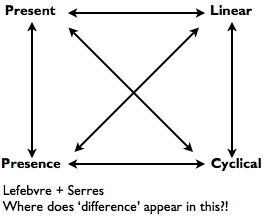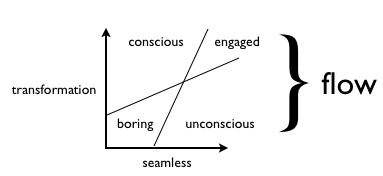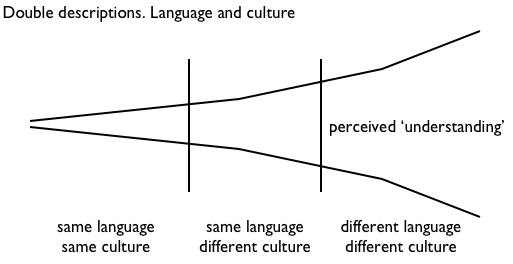American Society for Cybernetics, Annual conference, 9-15th August, 02011This 7-day conversational conference around the theme of 'listening' was organised by the American Society for Cybernetics (ASC) in Richmond, Indiana. The first two days were for members, the main conference lasted three days, followed by two days of seminars. It was organised by Larry Richards, Ranulph Glanville, Christiane 'Candy' Herr and Thomas Fischer (thank you all!).
|
|
This conference is already extensively documented on the official conference website http://www.asc-cybernetics.org/2011/ but for me it was a special event to which i would like to add my own notes.
Last years conference, held at RPI in Troy in the spectacular EMPAC building was a deeply inspiring event (not documented on this website). Even without that i would have attended this event as the conference theme of 'listening' has been close to my heart for quite a number of years.
|
The conference theme was ListeningI have been interested in listening/hearing probably since the first time i read 'Nada Brahma, The World is Sound' by J.E.Berendt in the 1980s. Later research related listening was introduced by William Gaver's papers on 'Auditory Interfaces', ' How do we hear in the world? Explorations in ecological acoustics', 'The SonicFinder' and 'An Interface That Uses Auditory Icons'. (Bill Gaver was involved in the making of the Apple System 9.0 finder sounds.)
Then a whole set of three extensive radio feature programs by J.E.Berendt became available on CD: "Nada Brahma, The world is Sound", "The Third Ear: On Listening to the World" and 'Muscheln in meinem Ohr" (available in German only). Altogether 14 CDs, accompanied by books of the same titles.
In 2001 I attended the 'Sound Practice' conference at Dartington College in Devon, UK. This event gave my interest a new and more profound direction. I gave a paper on a project that used sound and attended a workshop by Pauline Oliveros on 'deep listening'. My PhD dissertation also included a chapter on listening.
|
Below: Very messy notes:Probably riddled with misunderstandings, misconceptions and a distortion of what really went on. Apologies for that.
Tutorial 1: There is the impression that most Macy Talk attendees were from the hard sciences, while in fact there were: 70% from social, biological and medial sciences.
Jean-Pierre Dupuy's Categorisation: maths and information theory. Book: Mechanization of the Mind, Jean-Pierre Dupuy.
Presentations were about a transdisciplinary theory (which we are still looking for today! Although system science may fill this gap.). Remember the first version of Cybernetics Norbert Wiener called "Feedback mechanisms in biological and social systems". Von Foerster later suggested the title 'cybernetics' in honour of Wiener.
Problems:
1. Cognition, ai: The digital symbolic diversion.
2. Robots: Alienation of technology (+ critique of cybernetics)
3. ...
What is the essence of cybernetics? That behaviour changes through environment?
Tutorial 2: The pattern that connects, addiction (leads to adaptation). Dolphins and schizophrenia,
-"schismogenesis" - symmetrical and complementary
- DVD 'Steps to an ecology of mind'
- Batson's father coined the term 'genetics'
- Polynesia, Bali, Anthropology, 1937, "Nauven"
non-linguistic communication with animals.
Palo Alto: studying human behaviour
1973, PG was 17 attending course 'Ecology of mind'
a) Definition of Epistemology: "Branch of Philosophy how we know." Meaning how people know things. We have Epistemology? We have 'an' Epistemology?
b) How people know things?
It is about the 'how'.
Originally natural history was about perception and epistemological. Why natural history? It is about observation. Not philosophy but natural historic study of how things work. From there we infer concept of how knowledge works (how otters play).
Book: CofC has four different definitions of adaptation!
"Imagine a description of an organism and its environment. This description will consist of an internally interlocking tangle of descriptive propositions. Divide this tangle according to taste into two parts: 'organism' and 'environment'. Next 'adapted' and 'adaptation' (the latter being the process of becoming aware of the former) are words which refer to certain sorts of redundancy across the arbitrary dividing line." C of C, p. 98
Indra's net: Buddhism / Hinduism talks about an interconnected universe. Web of jewels in which each is reflecting all. (sounds like alchemy?)
"Everything in the nervous system stays in the nervous system."
Double-bind (Alice, butter-butterfly): we not only cannot escape what will get us, but we have to do it anyway.
Redundancy: commonality in pattern (b + e = arbitrary)
Creativity is the way out of the double-bind. Do something new!
TF: What if creativity is part of the mission? Isn't it different levels?
"Ways of thinking about ways of thinking" (Judy: "of which this is one")
RG: "Teaching i a con. It is about getting people in a difficult situation that they only can solve with creativity."
TF: The problem stays - but we want to change the conditions of the problem. What is a problem? Something you ... ?
In design the solution describes the problem. Design practice is circular practice that leads to new places. Listening to the other brings novelty to each.
|
|
Workshop 2: Listening as an creative and originating act.
Michael Serres: Sound is energy and can destroy you. Silence is the exception. (Can the latter be true? For most people the absence of noise was normal. Noise has only been around since the industrialisation. Or a busy crossing in ancient Rome.)
|
|
Different cities have different speeds of walking.
In mediterranean cities governments are weak and the people have to go out, be present and visible and talk a lot.
What about population size of countries? For example Switzerland, the Netherlands and Scandinavian countries have a strong sense of identity and of the idea of the commons, as there are bigger and stronger countries in the neighbourhood.
This idea also reminds of Levine: Geography of time. And Gladwell's ideas around language and hierarchy.
It is unconscious rhythms that determine our culture.
Film: Excerpt of mid-eighties film in which people change the (subliminal) background music in a fast food restaurant and people start behaving differently.
|
|
Few notes from this workshop. It addressed briefly Pask's conversation model. Then introduced the diagram above.
Learn more about Pask's model of conversation here: "Architecture and conversations" by Paul Pangaro. A short introduction including Pask's conversation model. http://www.cyberneticians.com/video/gms-usman-8mins30fps480x360.mov
|
The listening organisationGanesh
small eyes: concentration
big ears: listening
- communication and control
- feedback
- variety matching
- transducer
- amplification ∼ attentuation
James Grier Miller's 'living systems theory': http://www.newciv.org/ISSS_Primer/asem14ep.html
KK: You cannot talk to organisations and organisations cannot talk. Adopting biological models to humans is perhaps facist or totalitarian. Only people talk so only here we can talk about conversations.
Ross Ashby "The ultrastable system" http://www.panarchy.org/ashby/adaptation.1960.html
|
MJ: Anxiety, Risk and AttachmentBook: John Bowlby (1969) Attachment and Loss.
Viable Systems Model
We always use models to think about the world.
Book: Neisser, The perceptual cycle
|
|
Conversation:
Therapeutic listening
How do we measure listening?
Create (inner) space for someone. Take oneself out.
Active listening, passive listening.
Personal listening
...
Communication is not conversation.
Once people are in sync it becomes communication: 'background snap'
From understanding to new understanding.
From concrete to abstraction.
Creative listening happens so that two people [can understand].
How do we distinguish creative listening?
Something is wrong and then we have to be creative.
If i listen creatively i become someone else.
We are natural speakers but not natural listeners.
We need to teach the skills of listening.
How do we know someone understands us?
They do something with IT.
Perhaps something opposing? Intervening?
Can you agree and still continue the conversation?
You have to understand enough to disagree.
Merely mental? Or merely emotional?
How can we learn listening?
Does the moon listen to the sun? (film?)
How do we create the atmosphere?
Openness?
When we name it we kill it. The it is fed to the insensitive.
What is design thinking? A theory of knowing? What is a designer?
Take everything away and see what is left.
George Spencer Brown: Laws of Form
Some-thing from No-thing.
When i talk i listen to myself.
When i listen i listen to myself.
Bring together:
1. Epistemology
2. ?
3. ?
4. ?
5. ?
TK:How does the designer understand what he does?
How does he create theory from knowledge?
Design experience from magnetic fields.
Vibrating steel plates are also about me: What is wrong with my epistemic framework that i am surprised? Manifest there frameworks and you can learn to ignore them. Actively manage 'difficulties' and 'frame works'.
|
It takes two to know oneBook: Gregory Bateson, Mind and Nature
Binocular vision (as a metaphor! i never get that.) - adding different views, not depth
Book: Graham Brown (justice, ...)
What are we doing when we listen with intensity to others, with empathy?
We can model a way of other's perceiving.
'true listening' in generous moments.
double description
Experiencing another perspective of the world.
A theory of mind.
- constructing the other
- constructing the self
Human design
Ronald McIntire Theory of mind?
http://www.csun.edu/~vcoao087/pubs/RTM.pdf
PO: "Listening is applying short and long term memory.
TK: "Listening with your eyes"
RG: "In order to listen you have to give up that you already know.
'mindlessness' is emptiness.
Conversation: Double Bind
1. What about everything containing its opposite? Similar to Yin-Yang.
The colour green can be perceived as 'calming' but also as 'stifling'.
The colour red can be perceived as invigorating but also as too aggressive. Depending on own state.
2. Similar to starting the car in the morning with the radio coming to live with yesterdays volume. Immediately we turn it down because we perceive yesterday evening's volume as much too loud in the morning.
3. Book: Wade Davis describes in "Wayfinders" how languages contain unique perspectives and knowledge about the world. With every language that dies its as if a library burned down.
|
|
Generosity is not warm and fuzzy. Sharing food is about life and death as reciprocity. You share if you like it or not. Ethics. Reciprocal generosity.
Science as a type of listening. Listening to nature. Without imposing a view.
The diagram below tries to visualise my idea my insight on 'double descriptions' (it takes two to know one) that although you may think i am speaking English, i do not. English is my second language. Everything i say, although it may sound familiar, is actually coloured by a differing cultural framework.
Imagine on the left side a pair of twins that grew up together. Through their shared experience of parents, food, school and travels they might be able to understand each other very well. Beyond the right end we might even place other species.
This reminds of Thomas Nagel's 1974 essay "What is it like to be a bat?". I admit that comparison is a bit stretched. We are talking about language and using double-description to understand others and ourselves better, while Nagel explores different experiences of sensory perception or phenomenology.
Nagel writes:
"The more different from oneself the other experiencer is, the less success one can expect with [description of experience]. In our own case we occupy the relevant point of view, but we will have as much difficulty understanding our own experience properly if we approach it from another point of view as we would if we tried to understand the experience of another species without taking up its point of view." |
|
Language and culture is more difficult. Perhaps we can understand someone speaking a different language better when they have a similar interest or skillset - then someone with the same language and culture but very different background (for example two craftspeople building together a wooden house).
The immune system hasn't had time to learn a new environment.
Conversation theory
data deluge, too many messages
shared white space
Desire - generosity
Why do we do things?
There also is a bad side: Using empathy to be a Machiavelli.
Curiosity is part of aesthetics.
Energy is part of information.
Bateson: Complexity is an underlying value.
Requisite Variety
Making a choice i call ethics.
You need difference to make a choice.
Example: Judy's video presentation: Seeing with Judy's eye.
How can an organisation be proud of its criticism?
How do we group (sorting hat)?
The institute for study of attention.
KK: We are an island, in a society, in a world, that is different. A world that doesn't listen, that is dogmatic.
Why do we listen? Why are double descriptions valuable? Why is listening valuable?
Preliminary answer: There is a desire to listen. I listen because i want to understand (in order to learn). Is listening about love? |
Post-conference (Day 1)
From Tomatis' 'conscious ear'
p. 90 "To speak is to create interplay with another's body" Reading is connected to listening.
Silent reading is a late acquisition compared with reading aloud. It was highly unusual to read in silence.
p. 98 Art experience: Sculpture by Pillet's 'Crucible'
"I gradually saw my failure to understand contemporary art as a true deficiency. It was as if i was blind to something others could see. [...] Astonishingly enough, revelation did take place and in the most abrupt way: all of a sudden, i understood modern art. I do not mean to say that i merely understood the artists intentions, or that I could now tolerate looking at their works. I mean that in the twinkling of an eye, I recognised as my own this world which had remained closed to me until that moment. Without moving, chaos had rearranged itself before my eyes, into a new and rigourous order. Nothing had actually changed. It was I who was now situated inside this vision of the world outside."
'Responsibilities of Competence' (1971), von Foerster: soft problems are hard to solve. Hard problems are solvable.
Foerster's theorem 1: "The more profound the problem that is ignored, the greater are the chances for fame and success."
"The hard sciences are successful because they deal with the soft problems; the soft sciences are struggling because they deal with the hard problems."
Could it be that the 'soft' sciences have 'heavy metal' solutions (meaning they are computable)?
What are the competences of the hard sciences? What about Ayn Rand and Web 2.0?
Is Maxwell's daemon a cybernetic machine?
We need a torch to see the exchange which adds energy to the battery. (Second law of thermodynamics.)
Reality is entropy - but the world we know is not entropic?
Maxwell's daemon = (isomorph) to Universal Turing Machine (UTM):
- 1. read
2. compares
3. open ... if/then
4. change/write
5. repeat
Cybernetics is the link between the hard and the soft sciences!
(regulation, computation, ordering, entropy retardation)
Application:
neuro-sciences
education
society
humanities
Foerster's theorem No.: 3
"The Laws of Nature are written by man. The laws of biology must write themselves."
(Isn't the reverse true also? Well, not if it's spelled like this. |
Books mentioned:
|
ASC 2011 conference, Richmond, Indiana.
|
last update: 10/14/02015 15:17
|
| |
|
|
|














































